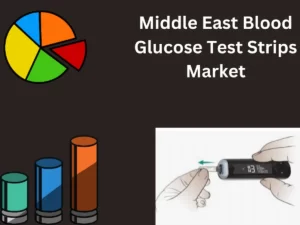
- Published 2024
- No of Pages: 200
- 20% Customization available
Middle East Blood Glucose Test Strips Market Research Report, Analysis and Forecast
Middle East Blood Glucose Test Strips Market Synopsis
The demand for blood glucose test strips in the Middle East is driven by several factors, including the growing prevalence of diabetes in the region, increasing awareness about diabetes management, and the growing availability and affordability of self-monitoring of blood glucose devices. According to the International Diabetes Federation, the Middle East and North Africa region has one of the highest rates of diabetes in the world, with over 22 million people living with the disease in the region. As a result, there is a growing need for affordable and accessible self-monitoring tools to help people manage their diabetes. The availability of test strips that are easy to use, affordable, and reliable, has made self-monitoring of blood glucose a popular option in the region. Additionally, with the rise in health consciousness and growing awareness of the importance of diabetes management, there is an increasing demand for self-monitoring tools like test strips.

In the Middle East region, the incidence of diabetes is among the highest in the world, with approximately 17.3% of the adult population affected by the disease. This has resulted in high demand for self-monitoring blood glucose devices, including test strips. In addition, the increasing adoption of telemedicine and the availability of innovative glucose-monitoring devices are also driving market growth in the region.
However, the high cost of glucose monitoring devices and the lack of healthcare infrastructure in some countries in the region pose significant challenges to the growth of the blood glucose test strip market in the Middle East.
The rise in disposable income and the increasing preference for self-monitoring of blood glucose levels are also driving the demand for test strips in the region. Additionally, the presence of established pharmaceutical companies and the increasing number of partnerships between local and international companies are also helping to boost the market in the region.
In conclusion, the growing prevalence of diabetes, the increasing awareness and availability of diabetes care products, and the rising disposable income are driving the demand for blood glucose test strips in the Middle East.
Middle East Blood Glucose Test Strips Market: Overview
Blood glucose test strips are small strips of chemically treated paper used to measure the level of glucose in a drop of blood. They are used by people with diabetes to monitor their blood sugar levels and to adjust their insulin doses.
There are three main types of test strips:
- Disposable or “Use and Throw” strips: These are single-use test strips that are discarded after each use. They are convenient and easy to use but can be expensive, especially for people who need to test their blood sugar multiple times a day.
- Reusable or “Built-in Indicator” strips: These test strips come with a built-in meter that measures the glucose level and displays the results. They are more cost-effective in the long run but require an initial investment in the meter.
- Continuous glucose monitoring (CGM) strips: These are specialized test strips that are used in conjunction with a wearable device to continuously monitor a person’s glucose levels. They provide real-time data and can alert the user if their glucose levels go too low or high.
In the Middle East, diabetes is a significant health issue, and many people use blood glucose test strips to manage their condition. The availability of test strips and glucose monitoring devices may vary depending on the country, but they can generally be purchased over the counter at pharmacies.
It is important to note that test strips should only be used as directed by a healthcare provider, and people with diabetes should follow their healthcare provider’s advice on how often to test their blood sugar and what to do with the results.
Saudi Arabia Blood Glucose Test Strips Market Synopsis
Saudi Arabia’s Blood Glucose Test Strips Market is still relatively small but is expected to grow significantly in the coming years. This growth will be driven by several factors, including an increase in the prevalence of diabetes and rising awareness about its management and prevention. Additionally, Saudi Arabia’s government has implemented several initiatives to improve access to healthcare services, which will further drive demand for blood glucose test strips in the country.
UAE Blood Glucose Test Strips Market Synopsis
The UAE Blood Glucose Test Strips Market is growing rapidly due to the increasing prevalence of diabetes in the region. The UAE has one of the highest rates of diabetes in the world, with an estimated 1.5 million people living with the condition. This has led to a surge in demand for blood glucose test strips, as they are essential for monitoring and managing diabetes. The market is also being driven by rising awareness about diabetes and its complications, as well as increasing access to healthcare services.
Middle East Blood Glucose Test Strips Market: Segmentation
The middle east blood glucose test strips market has been segmented into types and applications.
Based on the Strips type, the middle east blood glucose test strips market is split up into Use And Throw Built-in Indicator glucose test strips, and Continuous glucose monitoring (CGM) strips. In 2021, Use and Throw held a significant revenue share. Standard blood glucose test strips, such as use-and-throw strips, are reasonably priced and easily accessible. This is due to the fact that they provide accurate results in a short amount of time and require minimal effort in terms of both storage and maintenance. Additionally, these strips are very cost-effective, making them appealing to those with limited financial resources. For example, the price of use-and-throw test strips ranges from USD 0.10 to USD 0.20 per strip, whereas other types of test strips may cost up to USD 1.00 per strip.
Based on Applications, the market is classified as Type 1 Diabetes, Type 2 Diabetes, Gestational Diabetes, and Pre-Diabetes. In 2021, the segment is expected to account for a significant share of Type 2 diabetes. This is due to the rising prevalence of lifestyle diseases, such as diabetes, linked to an unhealthy diet and a sedentary lifestyle. The segment is also expected to benefit from the increasing availability of generic drugs and diagnostic tests. Additionally, the rising cost of insulin has had a significant impact on the segment. From 2014 to 2019, the average cash price for insulin climbed substantially—the average price per insulin unit climbed 54%, from $0.22 to $0.34. Then, from January 2020 to October 2021, it dropped 5%, from about $0.33 to $0.31.
Recent Developments
- In the year 2020
- Abbott Laboratories has released the FreeStyle Libre 2, a continuous glucose monitoring system that uses a small sensor to measure glucose levels in the fluid just beneath the skin.
- Roche Diagnostics has released the Accu-Chek Guide Plus, a blood glucose meter that uses a unique strip technology to provide fast and accurate results.
- Sanofi has released the iBGStar, a blood glucose meter that connects to an iPhone or iPod touch and allows users to track and more easily manage their diabetes.
- Dexcom has released the G6, a continuous glucose monitoring system that uses a small sensor to measure glucose levels in the fluid just beneath the skin.
- Ascensia Diabetes Care has released the Contour Next One, a blood glucose meter that uses a unique strip technology to provide fast and accurate results.
- In the year 2021
- Abbott Laboratories has released a new blood glucose test strip that requires only a tiny drop of blood, making it easier for people with diabetes to test their blood sugar levels.
- Roche Diagnostics has developed a new blood glucose test strip that can be used with a smartphone app to track blood sugar levels over time.
- Sanofi has developed a new blood glucose test strip that is designed to be used with a wearable device to monitor blood sugar levels.
- Moreover, Dexcom has developed a new blood glucose test strip that is designed to be used with a wearable device to monitor blood sugar levels
- Additionally, Abbott has developed a new blood glucose test strip that is designed to be used with a smartphone app to track blood sugar levels over time.
- Furthermore, Medtronic has developed a new blood glucose test strip that is designed to be used with a smartphone app to track blood sugar levels over time.
- Abbott has developed a new blood glucose test strip that is designed to be used with a smartwatch to monitor blood sugar levels.
In 2022, there were several acquisitions in the Middle East blood glucose test strips company space.
- In April 2022, the UAE-based healthcare company Neopharma acquired the Saudi Arabian diabetes care company Al-Nahdi Medical Company. The acquisition was part of Neopharma’s strategy to expand its presence in the Middle East and North Africa region.
- In June 2022, the UAE-based pharmaceutical company Julphar acquired the Saudi Arabian diabetes care company Al-Hada Pharmacy. The acquisition was part of Julphar’s strategy to expand its presence in the Middle East and North Africa region.
- In August 2022, the UAE-based healthcare company Al-Majd Medical Company acquired the Saudi Arabian diabetes care company Al-Hada Pharmacy. The acquisition was part of Al-Majd’s strategy to expand its presence in the Middle East.
- In October 2022, the UAE-based healthcare company Neopharma acquired the Saudi Arabian diabetes care company Al-Hada Pharmacymore. The acquisition was part of Neopharma’s strategy to expand its presence in the Middle East and North Africa region.
The Middle East Blood Glucose Test Strips Market is segmented as follows:
By Strips Type
- Use And Throw
- Built-In Indicator
- Continuous glucose monitoring (CGM) strips
By Application
- Type 1 Diabetes
- Type 2 Diabetes
- Gestational Diabetes
- Pre-Diabetes
By Region
- The Middle East
- Saudi Arabia
- UAE
- Qatar
- Kuwait
- Oman
- Rest of the Middle East
“Every Organization is different and so are their requirements”- Datavagyanik
Companies We Work With






Do You Want To Boost Your Business?
drop us a line and keep in touch

